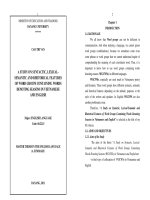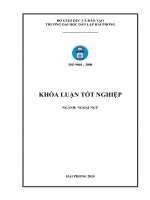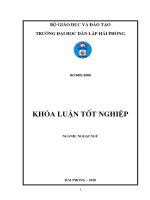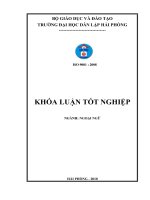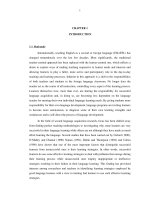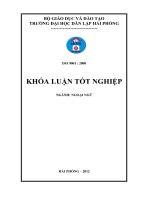A STUDY ON ENGLISH LEXICAL COLLOCATION AND PEDAGOGICAL IMPLICATIONS FOR BUSINESS ENGLISH
Bạn đang xem bản rút gọn của tài liệu. Xem và tải ngay bản đầy đủ của tài liệu tại đây (147.85 KB, 19 trang )
University of Languages and International studies
Vietnam National University of Hanoi.
Post Graduate Department
A STUDY ON ENGLISH LEXICAL COLLOCATION
AND PEDAGOGICAL IMPLICATIONS
FOR BUSINESS ENGLISH
SEMANTICS
Final Assignment
Student:
Phạm Thị Nguyệt
Cohort: K18
Instructor: Dr. Ha Cam Tam
Deadline: 28/06/2010
Hanoi, June 2010
English Lexical Collocation and Pedagogical Implications
for Business English.
TABLE OF CONTENTS
Part A: INTRODUCTION..........................................................................3
1. Rationale................................................................................................................3
2. Aims of the study....................................................................................................3
3. Scope of the study...................................................................................................4
4. Design of the study.................................................................................................4
Part B: DEVELOPMENT...........................................................................4
1. Theoretical Background and Review of Related Literature..............................4
1.1. Definitions of Collocation...............................................................................4
1.2. Related studies of Collocation.........................................................................6
1.3. Related Terms of Collocation..........................................................................6
1.4. Classification of Collocation...........................................................................7
1.5. The significance of English Lexical Collocation............................................9
2. Implications in learning and teaching Business English....................................9
2.1. The significance of Lexical Collocation in Business English........................9
2.2. Pedagogical implications...............................................................................10
2.3.1. For non-native teachers..........................................................................11
2.3.2. For learners.............................................................................................11
Part C: CONCLUSION............................................................................12
1. Limitations of the study........................................................................................12
2. Recommendations for further study....................................................................12
REFERENCES........................................................................................14
APPENDIX.............................................................................................17
Pham
Thi Nguyet- K18C
2
English Lexical Collocation and Pedagogical Implications
for Business English.
Part A: INTRODUCTION
1. Rationale
Vocabulary and grammar are two basic elements of a language, but traditionally most
EFL teachers often emphasize learning grammar more than vocabulary in their
teaching. With the approaching new millennium, pioneer scholars and researchers have
started to direct people’s attention to EFL vocabulary acquisition and began to
emphasize the instruction of vocabulary in classroom practices (Channel, 1981;
McCarthy, 1984; Nation, 1990). Collocations, as a central aspect of vocabulary, have
started to gain increasing attention in the past two decades.
Business English is an individualized learning program which “represents a radial new
approach to the provision of in-service business English course (Wilberg & Lewis,
1990:8). This program depends on the lexical approach emphasizing the collocation
and word grammar.
In the business world, there are a huge number of collocations which express specific
ideas very succinctly, for example, 'customer service’, ‘quality control'. If learners are
not familiar with these collocations, they will be forced to explain the concept, which is
likely to lead to errors and puts a strain on the listeners. Therefore, learning and
teaching business collocations can be particularly problematic for learners and nonnative teachers.
2. Aims of the study
The purposes of this study are to focus on giving brief understanding of Collocation,
the significance of Collocation and its implications for Business English. The current
study has attempted to explore the relation between English collocations and business
English, more specifically, the role lexical collocations play in learning and teaching
business English.
Pham
Thi Nguyet- K18C
3
English Lexical Collocation and Pedagogical Implications
for Business English.
Collocation is not really a new semantics area. It is the fact that there are many studies
on this from 1990s. However, I explore this topic with the hope that I could gain more
knowledge about collocation; obtain more examples involved in lexical collocations
for my better teaching.
3. Scope of the study
Due to the limited time and knowledge, this study just has brief understanding of
collocations in general and lexical collocations in particular. More importantly, some
implications for teaching and learning business English are explored basing on
previous studies and drawn from the author’s own teaching experience.
4. Design of the study
There are three main parts of this study. Part A: Introduction deals with rationale, aims,
scope and design of the study. Part B: Development can be broken into Theoretical
background and Implications in learning and teaching business English. In order to
have an overview of collocation, different definitions, relates studies, related terms,
classifications and significance are briefly stated. Pedagogical implications of
collocation for both non-native teachers and learners are clearly stated. Part C:
Conclusion involves some limitations and recommendations for further studies.
Part B: DEVELOPMENT
1. Theoretical Background and Review of Related Literature.
1.1. Definitions of Collocation
In the actual fact, words are rarely used alone. They live with each other and depend
much on each other. Word meaning is also governed by the meanings of other words
which tend to occur in its environment, for example, capital in loan capital and
capital in Hanoi capital. It is clearly that capital in these examples acquires different
meanings when combining with different words. We, therefore, should look at the
relations between words when describing meanings of words.
Pham
Thi Nguyet- K18C
4
English Lexical Collocation and Pedagogical Implications
for Business English.
Below are some definitions of Collocation by linguists.
1990
Aghbar
A collocation, in its simplest definition, consists
of two words which are linked together in the
memory of native speakers and occur together
with some frequency in both written and oral
discourse.
1990:158
McCarthy
The likelihood of co-occurrence between words
1990:32
Nation
Collocations are words that often occur together
and the collocations of a word are the company
it keeps.
1991:302
Malmkjaer
Collocation and set, as terms in a lexical
descriptions, are analogous to structure and
system in grammatical theory. The difference is
that collocation is a relation of probable cooccurrence of items, and sets are open-ended.
1997:8
Lewis, M.
Collocation
is
the
readily
observable
phenomenon whereby certain words co- occur in
1998:85
2002
natural text with greater than random frequency”
Dudley Evans & Collocation describes the company that a word
St John
keeps
Oxford
Collocation is the way words combine in a
Collocations
language to produce natural- sounding speech
Dictionary
and writing.
In its broadest sense, collocation is the way in which words co- occur in natural texts in
statically significant ways, as Lewis (2000.132) stated. In other words, collocation is
about the way words naturally co- occurs. It means although many word combinations
Pham
Thi Nguyet- K18C
5
English Lexical Collocation and Pedagogical Implications
for Business English.
are possible, we tend to use common and regular combinations of words collocation.
Moreover, collocation is not determined by logic or frequency, but it is arbitrary,
decided only by linguistic convention. Some collocations are fully fixed, such as do the
photocopying, or low-key competition while others more or less fixed and can be
completed in a relatively small numbers of ways, for example, enter/ abandon/
dominate/ corner/ drive another market.
1.2. Related studies of Collocation:
It has been 27 years since the appearance of Lewis’ (1993) book, The Lexical
Approach, directing language teachers’ attention to the systematic re-examination of
the importance of collocations in EFL/ESL education. Along with Lewis, scholars of
second language vocabulary acquisition (Bahns & Eldaw, 1993; Howarth, 1998),
EFL/ESL materials and curriculum design (Coady & Huckin, 1997; McCarthy, 2004a,
2004b; Richards & Rogers, 2001), pedagogy (Ellis, 1996, 2001; Nation, 2001), and
lexicography (Benson, Benson & Ilson, 1986, 1997), have also advanced arguments
advocating the necessity of studying English collocations.
First brought up by Palmer (1933) and later introduced to the field of theoretical
linguistics by Firth (1957), the most commonly shared definition of collocations is: the
tendency of one word to co-occur with one or more other words in a particular domain
(Aghbar, 1990; Al-Bahrain, 1998; Gitsaki, 1999; Nation, 2001; Nesselhauf, 2003). In
his monograph Second Interim Report on English Collocations, the father of
collocation studies, linguist Palmer (1933) simply states, “Each [collocation] … must
or should be learnt, or is best or most conveniently learnt as an integral whole or
independent entity, rather than by the process of piecing together their component
parts” (Palmer, 1933, p. 4). The notion, collocation, however, is far from thoroughly
described or understood as to whether it should be approached from a semantic,
syntactic, or idiomatic, perspective (Hsu, 2005).
Pham
Thi Nguyet- K18C
6
English Lexical Collocation and Pedagogical Implications
for Business English.
1.3. Related Terms of Collocation
Lexical chunk
'Lexical chunk' is an umbrella term which includes all the
other terms. We define a lexical chunk as any pair or group of
words which are commonly found together, or in close
proximity.
A collocate
A collocate of a particular word is another word which often
occurs with that word. If two or more words collocate, they
often occur together. Ex: company is an allocate of run.
A marked collocation
Collocation range
A marked collocation is an unusual combination of words that
challenges hearers or readers’ expectations.
Collocation range is a list of the other words with which a
word may occur (Larson, 1984:145). In other words,
collocation range refers to a set of possible collocates. It is the
collocation range that restricts the meaningful usage of each
word since it varies from word to word. No two words have
exactly the same collocation possibilities even the equivalent
words between languages. Some words have a limited one.
For instance, the English adjective bandy has a very limited
collocation range. It may allocate with legs, and it is unlikely
to occur with any other words. On the contrary, the noun
“appointment” has a large list of collocates such as have,
make, arrange, fix.
Collocation meaning
Collocation meaning refers to the associations that a word
acquires in its collocation. For example, pretty girl/ flower/
garden/ color/ village. A word can gain different collocation
meaning in different context. e.g. white man/ wine/ noise/
Pham
Thi Nguyet- K18C
7
English Lexical Collocation and Pedagogical Implications
for Business English.
coffee
1.4. Classification of Collocation
Collocations can be divided into lexical collocations and grammatical collocations. In
this much narrower terminology, lexical collocations combine two equal lexical
components ( open class words) while grammatical collocations combine a lexical
word, typical a noun, a verb or an adjective, with a grammatical word ( one open class
word and one closed class word). In other words, lexical collocations can be
understood as a pair of content words commonly found together.
Examples of grammatical collocations:
Noun+ Preposition: relationship with
Noun + to infinitive/that clause: a pleasure to, an agreement that
Preposition + Noun: in advance
Adjective + preposition: responsible for
Adjective + to infinitive/ that clause: ready to/ aware that
Verb + preposition: start up
Six subtypes of lexical collocations were suggested by the BBI Dictionary of English
Word Combinations (Benson et al., 1997) and the seventh ‘noun + noun’ subtype were
recognized by Hausmann (1999) and Kimmes (2004). Altogether, seven subtypes of
lexical collocations were investigated in this study.
Type
L1 verb + noun
L2 adjective + noun
Examples
impose taxes, do business, launch a new product, lay off
staff, go into partnership, cease trading
a rough design, tough competition, intended recipient,
limited company, annual turnover
Pham
Thi Nguyet- K18C
8
English Lexical Collocation and Pedagogical Implications
for Business English.
L3 noun + verb naming an
action
Shares are issued
L4 Noun 1 of noun
2
L5
adverb + adjective
balance of trade
L6 verb + adverb
appreciate sincerely, argue heatedly, complain bitterly,
affect deeply
L7 noun + noun
company uniform, market research, household goods,
consumer durables, sales figures
poorly paid, closely related, highly skilled.
1.5. The significance of English Lexical Collocation
Lexical Collocations are more problematic for non-native teachers and learners, also
more difficult to find in dictionaries. No reasonable explanation would be readily
available for native speakers using such natural-sounding word combinations as reach
an agreement. There are often no rules about how to put words together in such ways.
They can be a potential source of mother tongue interference for non-native speakers of
English as the collocation patterning is just typical in its nature.
Lexical collocations run through the whole of the English language. It is obvious that
they better serve to reflect the world’s states of affairs than grammatical collocations
based on the fact that lexical collocations are basically made up of open class words
which are lexical content words in direct connection with external reality.
Given the fact that up to 80% of the words in both spoken and written discourse are
chosen according to the lexical co- selection principle rather than to purely
grammatical factors (Sinclair, 2000: 197), this study just focuses on analyzing lexical
collocations.
2. Implications in learning and teaching Business English
Pham
Thi Nguyet- K18C
9
English Lexical Collocation and Pedagogical Implications
for Business English.
2.1. The significance of Lexical Collocation in Business English
According to Hammer (1991:157), knowing how to use a word includes knowing what
words can occur with it. Another linguist, Nation (1990:31-32) believes that knowing a
word involves knowing its collocations as well as its grammatical patterns and other
features of the word. Hill and Lewis (1997:i) argue that knowing strong and frequent
combinations is essential for accurate, natural English. For short, it can be said that
collocation is a fundamental aspect of vocabulary. It is an important organizing
principle in English vocabulary in particular. For example, to understand the word
“bankrupt”, we should know the word “go” which always goes with “bankrupt”.
In order to learn Business English, the teachers and learners have to know the key role
of vocabulary proficiency. It is fact that one of the most difficulties the learners of
business English usually encounter is memorizing collocations and using them
properly. It means that they should have a high awareness of the significance of
collocations in business English.
English for business obtains a group of important keywords, therefore, learners has the
task of finding and recording important word partnerships. Those keywords are the
core business vocabulary with higher frequency. Students while learning business
English have to choose their own keywords and find out the lexical collocations. For
instance, some keywords such as market, personnel, sales, product, debt, and projects,
are occurred with high frequency.
The learners also have to divide background words provided basically into verb-noun,
adjective-noun, and verb-adjective-noun groups and then make sentences with them.
The learning of word partnerships can give learners a quick way to master the
proficiency required. Usually business students have a large vocabulary, but they don’t
know how to combine the words together. When they need to express in English, they
can come up with many words in mind, while they are difficult to make meaningful
phrases or sentences that are well organized. For example, when they have the word
“campaign”, they often confuse to choose a word preceding “campaign”, whether it is
Pham
10 Thi Nguyet- K18C
English Lexical Collocation and Pedagogical Implications
for Business English.
“advertising”, or “advertisement”. The same case happens with the choice between the
word ‘market”, or “marketing” before the word “research”. So it is important to build
up the word partnerships. It is obvious that vocabulary of business English is needed
for production purposes. Thus storage and retrieval are significant. The technique of
learning vocabulary involves cognitive processing rather than mechanical learning of
lists. Collocation is one of the effective ways to gather vocabulary and facilitate
cognitive processing (Dudley-Evans & St John, 1998).
2.2. Pedagogical implications
Business English is English for specific purposes based on a lexical approach and
individual learner’s needs. It is an effective way to increase learners’ vocabulary, which
is the fundamental and crucial element for language learning. Teacher is the consultant
and the language audit to help students find their needs and to stimulate and motivate
them to use the language as much as possible. This study is carried out with the hope
that it can contribute some pedagogical implications for both non-native teachers ands
learners.
2.3.1. For non-native teachers
Actually, it is the requirement for non-native teachers of possessing as many
collocations as possible to teach business English. Moreover, they have the task of
raising awareness for learners of the significance of collocations in learning business
English. Teachers can at least try to provide EFL learners sources of lexis, such as
corpus, concordance, and dictionaries of collocations, ensuring these learners to have
direct exposure to chunks of English language and learn to extract and use patterns of
lexical collocations effortlessly. One of the main obstacles to teach lexical collocations
systematically, however, is their number, which amounts to tens of thousands. For noun
+ verb and verb + noun collocations, there is, for a considerable portion of them, direct
translational equivalence. Such lexical collocations do not have to be taught. The
teaching of lexical collocations in EFL should concentrate, instead, on items for which
there is no direct translational equivalence in English and in the learners' respective
Pham
11 Thi Nguyet- K18C
English Lexical Collocation and Pedagogical Implications
for Business English.
mother tongues. Along with these, non-native teachers should apply appropriate
methods of teaching collocations. Among them, they can design some typical exercises
on collocations for learners. Below are some kinds of exercises I myself- a teachers of
business English- find most suitable, efficient for learners.
2.3.2. For learners
Based on the current study, the first implication we can make is to suggest learners to
learn and use a wide variety of lexical collocations as they seem to help more than
merely putting as many collocations as possible.
Learners are also required to use their own keywords and collect background words by
using a dictionary or talking to their teachers. In this way, they can provide the carrier
content to meet their personal needs. Collocation is not determined by logic or
frequency but is arbitrary, decided by linguistic convention. To put it in another way,
collocations are not words which learners can put together, they co-occur naturally. For
that reason, the learners should spend time on learning, doing more exercises, and
obtaining good memory techniques, also collecting more collocations in order that they
can speak naturally.
The learners can see some typical exercises to develop vocabulary proficiency in using
business collocations in Appendix part.
The next pedagogical implication concerns the subtype of lexical collocations for
learners. Among seven subtypes mentioned before, EFL teachers should especially
concentrate on the practice of the subtypes which learners have not still mastered well
or score low in the tests.
Part C: CONCLUSION
1. Limitations of the study
The first limitation of this study is related to the scope of collocations investigated.
This study only examined lexical collocations and did not include grammatical
collocations.
Pham
12 Thi Nguyet- K18C
English Lexical Collocation and Pedagogical Implications
for Business English.
Another limitation of this study is related to the lack of time and convenience to collect
more examples of business collocations with the subtypes “adverb + adjective, verb +
adverb, adjective + noun”.
Last but not least, due to the limited time and knowledge, I could not afford to conduct
a deeper research on lexical collocations in business English, although I am teaching
business English for my students in my university, which I could take many
advantages.
All these above limitations will give an access for further study.
2. Recommendations for further study
The study concerning the distribution of lexical collocations in the process of learning
and teaching business English may lead to the possible understanding of collocation
learning ability. A better understanding will be useful to both researchers and teachers
in the improvement of materials selection, syllabuses, and teaching methods. Several
recommendations can be made.
First, future studies could consider exploring the use of grammatical collocations in
business English. Second, because the current study just looked at the subjects’ use of
collocations in relation to learning business English, future studies could investigate
the relationship between the use and even knowledge of lexical collocations and
English for other specific purposes such as Banking, Tourism, or Hospitability. Third,
further studies could go deeply into the relations between the use of collocations and
other language skills including speaking, listening, reading, and writing. Last, it could
be a new direction to continue investigating whether there are some patterns of
development in the EFL learners’ use and knowledge of lexical collocations
particularly related to the seven subtypes. The above are some potential directions this
current study can recommend for future studies on collocations.
Pham
13 Thi Nguyet- K18C
English Lexical Collocation and Pedagogical Implications
for Business English.
REFERENCES
1. Aghbar, A.A. (1990, October). Fixed expressions in written texts: Implications for
assessing writing sophistication. Paper presented at a meeting of the English
Association of Pennsylvania State System Universities. (ERIC Document
Reproduction Service No. 352 808
2. Bahns, J., & Eldaw, M. (1993). Should we teach EFL students collocations? System,
21(1), 101–114.
3. Benson, M., Benson, E., & Ilson, R. (1986). The BBI combinatory dictionary of English.
Amsterdam: John Benjamins Publishing Company.
4. Benson, M., Benson, E., & Ilson, R. (1997). The BBI dictionary of English word
combinations. Amsterdam: John Benjamins Publishing Company.
5. Coady, J., and Huckin, T. (Eds.) (1997). Second language vocabulary acquisition.
Cambridge: Cambridge University Press.
Pham
14 Thi Nguyet- K18C
English Lexical Collocation and Pedagogical Implications
for Business English.
6. Channell, J. (1981). Applying semantic theory to vocabulary teaching. English
Language Teaching Journal, 35, 115–122.
7. Dudley-Evans, T. & St John, M. J. (1998). Development in English for specific
purposes: A multi-disciplinary approach. Cambridge: Cambridge University
Press.
8. Ellis, N.C. (1996). Sequencing in SLA: Phonological memory, chunking and points of
order. Studies in Second Language Acquisition, 18, 91–426.
9. Ellis, N.C. (2001). Memory for language. In P. Robinson (Ed.), Cognition and second
language instruction (pp. 33–68). Cambridge: Cambridge University Press.
10. Firth, J, R. (1951) “ Mode of meaning”, in Firth, J, R. (ed.) (1957) Papers in
Linguistics, Oxford University Press.
11. Hausmann, F.J. (1999). Collocations in monolingual and bilingual English dictionaries.
In I. Vladimir & D. Kalogjera (Eds.), Languages in contact and contrast: Essays
in contact linguistics (pp. 225–236). Berlin: Mouton de Gruyter.
12. Howarth, P. (1998). Phraseology and second language proficiency. Applied Linguistics,
19(1), 24–44
13. Kimmes, A-M. (2004). An investigation of the usage and collocability of English verbs
of thinking based on the online edition of the New York Times. Unpublished
masters thesis, Southern Connecticut State University, New Haven, Connecticut,
USA.
14. Lewis, M. (1993). The lexical approach: The state of ELT and a way forward. London:
Language Teaching Publications.
15. Lewis, M. (1997). Implementing the lexical approach: Putting theories into practice.
London: Language Teaching Publication
16. Lewis, M. (2000). Teaching collocation: Further developments in the lexical
approach. London: Language Teaching Publications.
17. Malmkjaer, K. (ed.) (1991) The Linguistics Encyclopedia, Routledge.
Pham
15 Thi Nguyet- K18C
English Lexical Collocation and Pedagogical Implications
for Business English.
18. McCarthy, M. J. (1984). A new look at vocabulary in EFL. Applied Linguistics, 5(1),
12-22
19. McCarthy, M. (2004a, August). Collocation in vocabulary teaching and learning.
Lecture given at the meeting of JACET summer seminar program, Gunma, Japan.
20. McCarthy, M. (2004b). Touchstone: From corpus to course book. Cambridge:
Cambridge University Press.
21. Nation, I. S. P. (1990). Teaching and learning vocabulary. New York: Newbury House.
22. Nation, I. S. P. (2001). Learning vocabulary in another language. Cambridge:
Cambridge University Press
23.
Palmer, H.E. (1933). Second interim report on English collocations. Tokyo:
Kaitakusha
24. Richards, J.C., & Rogers, T.S. (2001). Approaches and methods in language teaching
(2nd ed.). Cambridge: Cambridge University Press.
25. Wilberg, P. & Lewis, M. (1990). Business English: An individualized learning
programme. London: Language Teaching Publications
Some websites:
1. />2. />3. />4. />5. />6. o/Articles_1/tasks.html
7. />8. />9. />10. />
Pham
16 Thi Nguyet- K18C
English Lexical Collocation and Pedagogical Implications
for Business English.
11. />
APPENDIX
Type 1: Matching
Exercise 1: Match the verbs and nouns concerning various important business
activities
1. Interview
2. Give
a.
b.
a raise
a problem
3. Attend
c.
job applicants
4. Organize
d.
a meeting
5. Book
e.
a room
6. Provide
f.
a service
Pham
17 Thi Nguyet- K18C
English Lexical Collocation and Pedagogical Implications
for Business English.
7. Deal with
g.
a conference
8. Manage
h.
merchandise
9. Develop
i.
advice
10. Manufacture
j.
a product line
11. Ask for
k. a new employee
12. Hire
Exercise 2: Match a noun and a noun to make a business collocation.
1. Interest
2. human
3. consumer
4. job
5. staff
6. market
7. quality
8. brand
9. company
10. sales
11. take-over
A.
B.
C.
D.
E.
F.
G.
H.
I.
J.
K.
awareness
control
bid
policy
figures
resources
turnover
rate
share
confidence
satisfaction
Type 2: Filling in the blanks.
Complete the following sentences with as many different words as you can.
1. In the late 1990s, Internet use was doubling every 10 days. Market …………….was
incredible.
2. Sexual …………..is when an employee behaves sexually towards another in a way that they
find unwelcome and unacceptable.
3. In large organizations, there is a human resources department (HRD) that deals with pay,
recruitment, etc.
Another name for this department is the…………….department
4. Debts that have to be paid within one year are current liabilities, and those payable in more
than a year are ………liabilities, for example bank loans.
Pham
18 Thi Nguyet- K18C
English Lexical Collocation and Pedagogical Implications
for Business English.
Type 3: Choosing the suitable collocates.
A. Which words normally collocate with the noun competition below?
1. big
2. fierce
3. hard
4. stiff
5. intense
6. challenging
7. stiff
8. tough
9. rough
10. risky
Pham
19 Thi Nguyet- K18C
